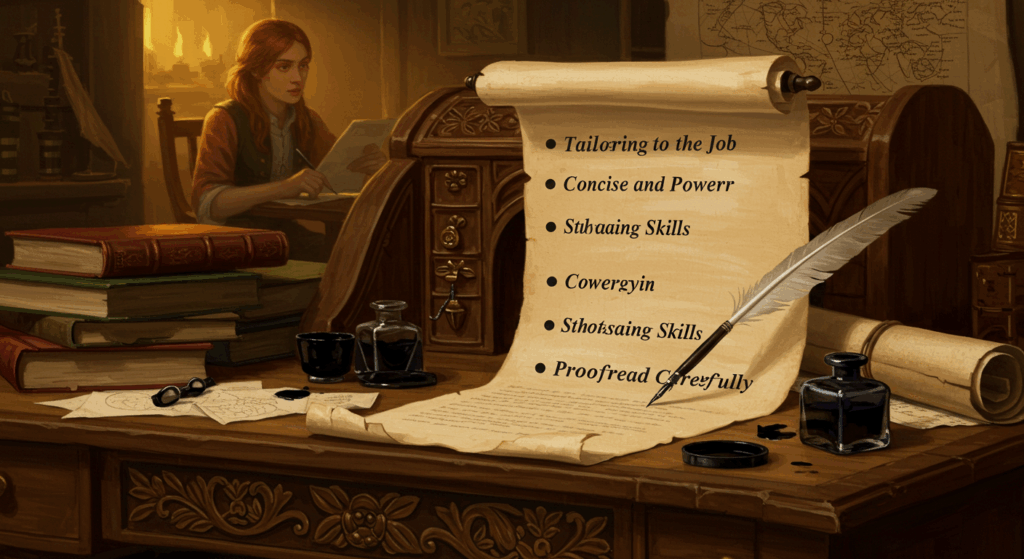Writing a cover letter can feel like that moment you open Netflix, scroll forever, and somehow still don’t hit play. It’s weirdly intimidating for something that’s literally… a page. But I get it. You’re trying to sound confident without coming off like a robot (or a try-hard), show personality but not overshare, and prove you can do the job without re-pasting your entire resume. Ngl, it’s a balance.
If you’ve Googled “how to write a cover letter” and got 2,000 different takes, same. This guide is the clear, friendly version I wish I had years ago—conversational, slightly messy (on purpose), loaded with practical steps, and sprinkled with examples you can actually copy-paste and adapt. We’ll walk through cover letter structure (like a pro), go section by section, and share writing tips that make you sound human. No fluff, no academic vibes, just stuff that gets interviews.
Take a breath. You’ve got this. Let’s build a cover letter that sounds like you on your best, most hireable day.
The Vibe Check: What a Cover Letter Is (and Isn’t)
A cover letter is your tiny one-page “why me + why this company” pitch. It’s not your autobiography, not a transcript of your resume, and not the place to list every tool you’ve touched since 2014. Think of it as a DM to the hiring team where you show you understand their problem and you’re excited to help solve it.
What it should do:
- Show you actually read the job post (and ideally peeked at the company’s site/socials).
- Connect 2–3 of your most relevant wins to the role.
- Sound like a warm, confident human, not ChatGPT on corporate mode.
- Make the recruiter’s life easy: clear, skimmable, and specific.
What it shouldn’t do:
- Rehash your resume line by line.
- Be generic (“I am writing to apply for the X role at Y Company…” snooze).
- Over-apologize (“While I don’t have experience…”—delete that energy).
- Go longer than one page. Please. For everyone’s sanity.
The Five-Minute Prep Before You Write (yes, it’s worth it)
Before we dive into the cover letter structure, do a fast little recon:
- Skim the job post and pull the top 5 respomsibilities or keywords. Circle the 2–3 you can absolutely crush.
- Peek at the company site/LinkedIn/press. What’s their tone? What do they brag about? Any current launches, values, or growth stats?
- Choose two stories (projects, achievements, “I solved X with Y” wins) that map to those responsibilities.
- Grab a name for your greeting if you can: the hiring manager, recruiter, or team lead. If not, “Hi [Team Name] Team” works—e.g., “Hi Growth Marketing Team.”
- Set your tone: warm, curious, helpful. If their brand is playful, match it. If it’s serious/healthcare/legal, keep it crisp but still human.
Now you’re primed. Let’s actually write this thing.
How to Write a Cover Letter (without sounding like a template)
Okay, here’s the simple, reliable cover letter structure that works for almost every role. We’ll go piece by piece, I’ll show snippets, and then we’ll put it together.
Header
At the top, match your resume branding: same name, contact info, LinkedIn/portfolio. Keep it clean.
Example:
Alex Jordan
alexj@email.com • 555-123-4567 • linkedin.com/in/alexj • alexj.dev
Greeting
Best case: use a name. If no name, use the team: “Hi Product Design Team,” or “Hello Customer Success Team,” or “Dear Hiring Team,” if the vibe is formal.
Opening Hook (3–4 lines)
Skip the “I am writing to express interest” filler. Instead, hook with a quick alignment: who you are, what you do, and why this role/company is exciting to you specifically.
Example:
Hi Growth Marketing Team,
Last quarter, I led an SEO + newsletter experiment that grew trials by 31% in eight weeks. So when I saw your posting for a Lifecycle Marketer—especially with your push into new B2B segments—I had to reach out. I love what you’re bulding around freemium → paid activation, and I think my growth playbook slots in cleanly.
Middle Paragraph(s): Proof You Can Do The Job
Pick 2–3 stories that directly connect to the role’s responsibilities. Use a mini STAR format: Situation → Task → Action → Result. Keep each story to 3–5 lines. This is where your writing tips matter: be specific, quantify if you can, and show your thinking.
Example structure:
- Story 1 (core skill #1): “At [Company], I [did X] to solve [Y]. Result: [metric/impact].”
- Story 2 (core skill #2): “I also [did A] which led to [B].”
- Optional Story 3 (bonus): “For [side project/volunteer/freelance], I [did C], proving I can [relevant skill].”
Example:
At Pine Labs, I revamped our onboarding emails by segmenting new users by intent (builders vs. non-technical). I A/B tested subject lines + CTAs and layered in a 3-touch nudge sequence. Net result: a 27% lift in Day-7 activation and a 14% bump in paid conversions over two months.
Before that, at Sidekick, I owned content + search. I built a zero-click resistant pillar strategy and expanded programmatic pages with QA guidelines. Organic signups increased 38% YoY, and I cut CAC by 19% by shifting spend to pages with 3x better intent fit.
Why Them + Culture Fit (2–4 lines)
Make it obvious you didn’t spray-and-pray. Reference a product, value, audience, or recent initiative and tie it to your motivations.
Example:
I’m especially drawn to your focus on helping SMBs get enterprise-grade tools—access matters. Your “default open” value reads like how I like to work: share context, then move. I’d love to help the team drive meaningful activation, not just pageviews.
Close (1–3 lines)
Be clear and confident. Invite next steps. Keep it kind but not clingy.
Example:
I’d love to share a few experiments I think could lift activation in your first 90 days. Thanks for considering—looking forward to chatting.
Signature
Add your name + any relevant links again if you like. Keep it neat.
So that’s the high-level how to write a cover letter flow. But let’s go deeper with the nitty-gritty writing tips and micro-edits that turn “fine” into “wow, interview this person.”
Cover Letter Structure That Actually Works (with quick templates)
Here’s a simple, reusable template you can adapt in 10 minutes. Delete the brackets and write like a human.
[Your Name]
[Email] • [Phone] • [LinkedIn] • [Portfolio]
[Date — optional]
Hi [Hiring Manager/Team Name],
[Hook: 2–4 lines connecting your most relevant win to the role + why you're excited about THIS company.]
[Story 1: STAR-style proof that maps to requirement #1. Keep to 3–5 lines. Include a result if possible.]
[Story 2: Proof for requirement #2. Add a metric or a quick before/after.]
[Optional Story 3: Bonus skill or relevant side project.]
[Why them: 2–4 lines referencing their product/values/recent initiative + why that matters to you.]
[Close: confident one-liner + call to action.]
Best,
[Your Name]
[Optional: short P.S. with a link to a portfolio piece or case study]
Mini-version (when you need short + punchy):
Hi [Team],
I [short win] and [another win]. I’m excited about [company-specific thing] and think I can help with [top 1–2 responsibilities].
Quick wins I’d explore in 30–60 days:
• [Idea #1]
• [Idea #2]
Open to share more. Thanks!
[Name]
This ticks all boxes for cover letter structure while keeping your voice intact.
Writing Tips That Make Recruiters Actually Read
Here are the writing tips that matter way more than people think:
- Lead with relevance. Put your most on-target story first, even if it’s not your biggest achievement ever. Relevance wins.
- Use simple language. Fancy words don’t make you smarter; clarity does. If you can say it in 8 words, don’t use 18.
- Numbers > adjectives. “Increased retention by 12%” beats “significantly improved retention.”
- Mirror the job post (lightly). If they emphasize “cross-functional,” show how you worked with design/ops/sales. Don’t keyword-stuff, just echo the themes.
- Show your thinking. One line about how you made a decision (e.g., “We prioritized features by support ticket volume + revenue impact”) makes you sound like a pro.
- Cut the fluff. Delete: “I believe,” “I think,” “I feel.” State it. “I can help your team launch X faster” is stronger than “I believe I can help…”
- Be findable. Include your LinkedIn/portfolio. If you build anything, link it. They will click. (Make sure it’s not broken. pls.)
- Tone-match the brand. If the company’s website uses humor, you can be playful. If they handle sensitive data, keep it sleek and professional.
- One page, with white space. Nobody wants a wall of text. Break paragraphs every 3–5 lines.
- Proofread once, then read it out loud. You’ll catch awkward phrasing instantly. Add a tiny “you know,” or “hmm,” if it suits you—but keep it clean overall.
Bonus: ATS-friendliness. Cover letters are usually read by humans, but some systems store them. Save as PDF with a normal filename (AlexJordan_CoverLetter_ProductMgr.pdf). Avoid images-only formats.
Examples by Role (so you can see the differences)
1st Example: Product Designer
Hi Design Team,
I’m a product designer who loves simplifying gnarly workflows. At Relay, I led a redesign of our onboarding for merchants moving from spreadsheets to our dashboard. By interviewing 10 users and mapping their first-week tasks, I cut time-to-value from 3 days to under 24 hours.I’m drawn to your mission to help small shops sell globally without extra headache. Your recent ShipNow launch tells me you value speed and clarity—same. I’d love to help you translate research into clean flows that move new users from “huh?” to “oh, this is easy” in minutes.
2nd Example: Software Engineer (Front-End)
Hello Front-End Team,
Last quarter at Crest, I led the migration of our design system to React 18 and introduiced strict type coverage with TypeScript (from ~40% to 95%). This cut UI regressions by 31% and sped up feature delivery by ~20%. I also built a visual testing workflow with Playwright + Chromatic to keep component changes safe.Your focus on performance and accessibility resonates. I’d love to help push your Lighthouse scores and expand component reuse across teams.
3rd Example: Customer Success
Dear Customer Success Team,
I’ve supported 200+ SMB customers across onboarding, renewals, and expansion. At Rover, I introduced a “first 14 days” playbook that raised product adoption by 19% and cut time-to-first-value by 40%. I care about proactive support: training, tailored resources, and quick loops with product.I’m excited about your mission to make powerful tools approachable. I’d love to help each new customer find quick wins and stay long-term.
Notice how each one uses the same cover letter structure but the content shifts to match the role’s must-haves.
How to Write a Cover Letter When You’re Changing Careers (or light on experience)
If you’re pivoting—say, from teaching to project management—or you’re a recent grad, here’s the move:
- Lead with transferable skills. Communication, stakeholder management, operations, research, data work, process improvement. Prove them with stories.
- Use projects. Freelance, volunteer, bootcamp, side projects count. Results count more than job titles.
- Bridge the gap explicitly. One sentence: “Although my title was [old thing], the work mirrored [new role]—planning sprints, managing stakeholders, and shipping deliverables on schedule.”
- Show learning momentum. Courses, certificates, repos, a Notion wiki of case studies—include a link.
Pivot example:
Hi Operations Team,
After five years teaching, I shifted into operations at a nonprofit where I built onboarding flows, automated intake, and managed cross-team communication. The work looks a lot like project management: tight deadlines, changing requirements, and clear metrics. I decreased onboarding time by 35% and raised participant satisfaction by 22% after standardizing checklists and dashboards. I’m excited to bring that same process brain to [Company] as an Associate PM.
You’re not “less than.” You’re just translating. That’s all a good cover letter is: translation with receipts.
The 10-Minute Edit Pass (aka the glow-up)
You wrote a draft. Great. Use this quick checklist to take it from fine to sharp:
- First line: Does it hook? Does it show you did research?
- Two best stories up front: Do they match the job post exactly?
- Numbers: Do you quantify at least one outcome per story?
- Company tie-in: Did you reference a product, value, or audience?
- Skimmability: Are paragraphs 3–5 lines max? Any bullets you can add?
- Tone: Do you sound like a helpful human, not corporate sludge?
- Typos: Read it out loud. Fix any weird commas or overly long sentences.
- Links: Are LinkedIn/portfolio/case studies included and working?
- Filename: Normal, not chaotic.
Name_CoverLetter_Role.pdf. - Length: One page. If it spills, cut the weakest story or tighten sentences.
Common Mistakes (and easy fixes)
- Generic greeting. If you can find a name, use it. If not, use the team name.
- Resume paste. Pick 2–3 stories and expand with context. Don’t list every bullet.
- Over-explaining. You don’t need your life’s story. Leave some for the interview.
- Too formal or too casual. “To Whom It May Concern” is dusty; “hey bestie” is unhinged. Aim for warm-professional.
- Jargon soup. If it sounds like a buzzword salad, chop it.
- No call-to-action. End with an invite to talk or share ideas.
- Apologizing. Replace “Although I don’t have…” with “Here’s how I’d approach…”
- No proof. “Hard worker” is nothing. “Launched X in 3 weeks with 0 rollbacks” is everything.
- Wall of text. Add white space and bullets. Your reader has 97 tabs open.
- Wrong company name. Triple-check. No one recovers from “Dear [Other Company]”. Eek.
Micro-Writing Tips That Quietly Impress
- Front-load verbs: “Led,” “shipped,” “designed,” “launched,” “reduced,” “grew.”
- Swap adjectives for metrics: “fast” → “in 10 days.”
- Show user empathy: Mention who benefitted—customers, ops, sales, support.
- Name constraints: “Shipped under strict compliance requirements,” “scaled to 1M MAU,” “under budget.”
- Add one thoughtful idea: In your close, offer a quick win you’d test. It shows initiative without doing free consulting.
These writing tips sound small, but together they make your letter feel intentional and high-signal.
Formatting Basics (because aesthetics matter)
You don’t need graphic-designer energy, but you do need clean formatting.
- Font: Something normal—Inter, Calibri, Helvetica, Georgia. 11–12 pt.
- Margins: 1″ all around, or 0.75″ if you need a tad more space.
- Spacing: Single or 1.15. Break paragraphs often.
- Length: One page max (half a page is okay for early career).
- File: PDF unless told otherwise. File name like
TaylorNguyen_CoverLetter_DataAnalyst.pdf.
Match your resume header so the set looks cohesive. Hiring teams notice when it’s tidy.
Real-World “Before → After” Rewrite (to see the difference)
Before (meh):
Dear Hiring Manager,
I am writing to apply for the Marketing Manager position. I am a results-oriented professional with excellent communication skills and a proven track record. I believe I would be a great fit for your company. In my previous role, I handled social media and email marketing. Thank you for your time and consideration.
After (better):
Hi Marketing Team,
At Finlo, I rebuilt our lifecycle emails and launched a referral test that together lifted trial-to-paid by 18% in Q2. I also partnered with Sales to add a warm handoff playbook, reducing churn in the first 60 days by 11%. Your focus on expanding B2B self-serve is exactly where I’ve been operating, and I’d love to help drive activation and early retention. If helpful, I can walk you through the sequence and the experiment plan that worked for us.
Same length, wildly different signal. That’s the magic of good cover letter structure and a few targeted writing tips.
Special Cases: Remote Roles, Startups, and Big Companies
- Remote roles: Emphasize async communication, documentation, and timezone coordination. A line like “I keep thorough notes and over-communicate decisions in writing” goes far.
- Startups: Show bias toward action. Highlight scrappy wins, speed, and wearing multiple hats. Offer a quick 30-60-90 idea in the close.
- Big companies: Emphasize cross-functional collaboration, navigating systems, and shipping at scale with quality standards/compliance. Mention stakeholders and process discipline.
Quick “How to Write a Cover Letter” FAQ (because you’ll ask anyway)
Do I need a cover letter at all?
If the application says optional, it’s still a chance to stand out. If time is tight and you’re applying to 20 roles, prioritize the top 3–5 you want most and write for those.
How long should it be?
Half a page to one full page. No longer. Short and specific wins.
Should I customize each one?
Yes, but keep a “base” version. Customize the hook, the top 2 stories, and the “why them” paragraph.
What if I don’t meet all the requirements?
Few people do. Focus on what you do bring and how fast you learn. Bridge the gap with similar wins.
Can I be funny?
A little humor is fine if the brand is playful. Don’t force it. Think “smile,” not “stand-up routine.”
Can I use AI to draft it?
Sure, but edit to sound like you. Add specifics only you know. (And triple-check names.)
A Full Example You Can Adapt (with natural flow)
Hi People Ops Team,
I’m a people-first HR generalist who cares deeply about building smooth, equitable processes. In the last year at Mistral, I led a compensation review, rolled out a new performance cycle, and trained managers on feedback practices. The result: promo cycle satisfaction increased by 24 points, and we reduced time-to-hire by 21% after tightening our intake process.Earlier, I rebuilt onboarding for distributed teams (US, EU, APAC). I introduced a 30-60-90 plan template, async welcome videos, and a buddy system. New hire ramp shortened by ~2 weeks, and our 90-day retention rose to 96%.
I’m excited about your commitment to transparency and employee growth. Your “default to documentation” value mirrors how I work: write it down so people can move. I’d love to help scale fair, simple systems as you grow to 500+.
If helpful, happy to share the onboarding blueprint and the manager training deck I created. Thanks for reading—I’d love to connect.
Feel the rhythm? Specific, skimmable, culture-aligned. That’s textbook how to write a cover letter energy.
Troubleshooting: When You’re Stuck or It Sounds Weird
- If your opening feels bland: Start with a result (“I grew X by Y%”) or a company-specific reason (“I’m excited about your mission to…”).
- If you’re rambling: Cut any sentence that starts with “I believe/feel/think.” Keep the claim, drop the hedge.
- If it’s generic: Add one detail only an insider would know: a product name, customer segment, or value.
- If it reads too stiff: Swap in a couple conversational phrases (“I’d love to…,” “Here’s the short version,” “Quick wins I’d explore…”).
- If it’s too casual: Remove slang, tighten punctuation, and keep full sentences. (You can keep one “hmm,” it’s fine.)
- If you’re repeating your resume: Zoom in on how you did it: decisions, constraints, collaborators, why it mattered.
Final Checklist (fast pass before you hit submit)
- Hook mentions a company-specific reason or a strong relevant win
- 2–3 stories with actions + outcomes
- Numbers where possible
- One short “why them” paragraph
- Friendly, confident close with an invite to talk
- One page, neat formatting, working links
- PDF file name that won’t make a recruiter cry
Ngl, that’s it. That’s the formula. Master the cover letter structure, keep your writing tips tight, and you’re already ahead of 80% of applicants who submit the same dusty template everywhere.
Wrap-Up: You Don’t Need Perfect—You Need Clear + Relevant
If you made it this far, you’re already taking this seriously, which honestly puts you ahead. The real secret of how to write a cover letter isn’t wild creativity or secret recruiter hacks; it’s clarity, relevance, and a voice that sounds like a person someone would want on the team. Keep it focused, make it skimmable, tie your wins to their needs, and show a little spark. Even if your path has zigzags (same), own it and translate it.
You’ve got stories worth telling. Put them on the page.
Ready to turn this into interviews? Open a doc, grab the template above, and draft your first letter in 20 minutes. Then apply to that role you’ve had open in a tab for days. Hit send. You’re closer than you think.









